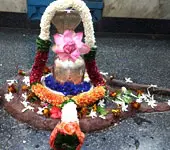Is Family's Permission Necessary For Becoming Sanyasi ?
Recommended for you
पुराणों के नाम

श्रीमद्भागवत और देवीभागवत दोनों ही भागवत नाम से जाने जात....
Click here to know more..Vedas - Holy Books Of Hinduism

All the four Vedas in PDF format translated into English....
Click here to know more..Nataraja Prasada Stotram

सम्पत्प्रदमिदं स्तोत्रं प्रातरुत्थाय यः पठेत्। अचलां श....
Click here to know more..Excerpt
Excerpt
Is family's permission necessary for becoming a sanyasi?
Who is a sanyasi?
Bhagawan says in Gita -
योगसंन्यस्तकर्माणं ज्ञानसंछिन्नसंशयम्।
आत्मवन्तं न कर्माणि निबध्नन्ति धनञ्जय।।4.41।।
Through yoga he relinquishes all karma.
He doesn't do anything anymore.
There is nothing left for him to do.
सम्यङ् न्यासीकृतः । समर्पितः ।
Relinquishing completely and in a proper way.
Relinquishment is not out of an impulse.
It is not an impulsive decision.
I am not getting what I deserve.
I am not getting a good job.
My family is not taking care of me.
I don't have friends.
Let me join an ashrama.
This is not sanyasa.
This is running away from life, dejected.
This is not sanyasa.
Becoming a sanyasi is a conscious decision, a responsible decision.
Then you relinquish everything in a proper way.
Hand over responsibilities.
Then slowly get out of worldly affairs.
This is the kind of sanyasa you will find mostly in our scriptures.
Krama sanyasa,
After completing all responsibilities as a householder, he then retires as a vanaprasthi.
Even during vanaprastha, he is not completely cut off from the family.
He is still there whenever they need him, like to advise them.
Then only comes sanyasa.
This is a path that everyone should aspire for, kramasanyasa.
In this case, sanyasa is happening with the complete knowledge and consent of the family.
There is another kind of sanyasa in which a person develops complete dispassion, vairagya towards the world and reliquishes.
This is from knowledge about the unreal nature of the world.
This can also due to practical experiences.
This is irrespective of whether he is a householder or a bachelor.
If vairagya is genuine, then he can relinquish as soon as he develops it.
On the same day.
When the world has turned disgusting.
Relations and permissions are matters of the world.
Then he doesn't wait for permissions.
And what are the signs of a sanyasi
His only aim is moksha and the only thing he does is worship.
Worship in any or many of its forms.
He wears saffron, red or appropriate clothes and usually a kamandalu and a staff.
Shaven head.
He lives in solitary places or holy teerthas.
But he doesn't stay at any place for long.
He doesn't want to get attached to any place.
He is very cautious about this.
He takes satwik food in a very limited quantity.
He survives out of food given by others voluntarily but he doesn't ask for anything.
He is non-aggressive, non-violent and peaceful.
Whether it is good or bad, he maintains equanimity.
And he stays away from women.
These are the signs of a sanyasi.

English Topics
Rare Topics
Click on any topic to open
- 237 The Practice of Bhojana Sadhana
- 236 Words of Wisdom - 2
- 235 Defining Goodness - Sanatana Dharma's Perspective
- 234 Vibhishana in Ramayana - A Tale of Morality, Loyalty, and Redemption
- 233 God will not let you break
- 232 A Glimpse into the 64 Arts
- 231 Chembai Vaidyanatha Bhagavatar - A Carnatic Maestro's Musical Odyssey
- 230 Understanding Adhyāsa: A Closer Look at False Attribution
- 229 Is Family's Permission Necessary For Becoming Sanyasi ?
- 228 Faith In Upasana
Please wait while the audio list loads..
30
Ganapathy
Shiva
Hanuman
Devi
Vishnu Sahasranama
Mahabharatam
Practical Wisdom
Yoga Vasishta
Vedas
Rituals
Rare Topics
Devi Mahatmyam
Glory of Venkatesha
Shani Mahatmya
Story of Sri Yantra
Rudram Explained
Atharva Sheersha
Sri Suktam
Kathopanishad
Ramayana
Mystique
Mantra Shastra
Bharat Matha
Bhagavatam
Astrology
Temples
Spiritual books
Purana Stories
Festivals
Sages and Saints
